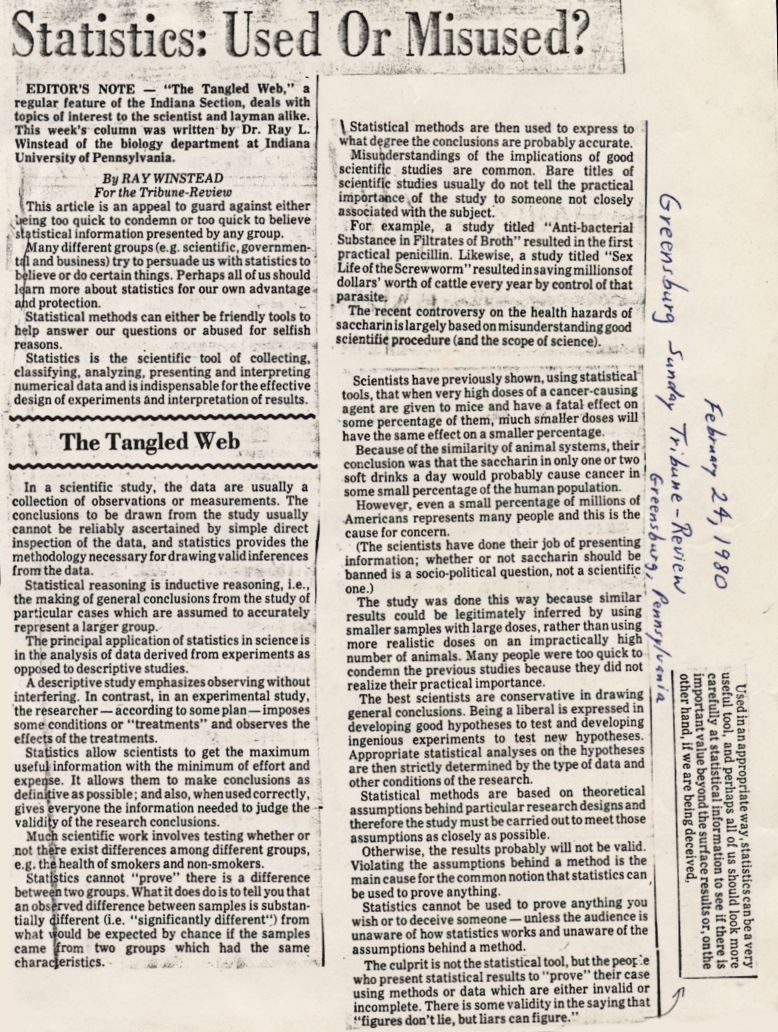Dr. Ray L. Winstead
Professor of Biology (retired),
Indiana University of
Pennsylvania


Statistics: Used Or Misused?
Greensburg Sunday Tribune-ReviewGreensburg, Pennsylvania
February 24, 1980
Editor’s Note – “The Tangled Web,” a regular feature of the Indiana Section, deals with topics of interest to the scientist and layman alike. This week’s column was written by Dr. Ray L. Winstead of the biology department at Indiana University of Pennsylvania.
By Ray Winstead
For the Tribune-Review
This article is an appeal to guard against either being too quick to condemn or too quick to believe statistical information presented by any group.
Many different groups (e.g., scientific, governmental and business) try to persuade us with statistics to believe or do certain things. Perhaps all of us should learn more about statistics for our own advantage and protection
Statistical methods can either be friendly tools to help answer our questions or abused for selfish reasons.
Statistics is the scientific tool of collecting, classifying, analyzing, presenting and interpreting numerical data and is indispensable for the effective design of experiments and interpretation of results.
In a scientific study, the data are usually collection of observations or measurements. The conclusions to be drawn from the study usually cannot be reliably ascertained by simple direct inspection of the data, and statistics provides the methodology necessary for drawing valid inferences from the data.
Statistical reasoning is inductive reasoning, i.e., the making of general conclusions from the study of particular cases which are assumed to accurately represent a larger group.
The principal application of statistics in science is in the analysis of data derived from experiments as opposed to descriptive studies.
A descriptive study emphasizes observing without interfering. In contrast, in an experimental study, the researcher according to some plan – imposes some conditions or “treatments” and observes the effects of the treatments.
Statistics allow scientists to get the maximum useful information with the minimum of effort and expense. It allows them to make conclusions as definitive as possible; and also, when used correctly, gives everyone the information needed to judge the validity of the research conclusion.
Much scientific work involves testing whether or not there exist differences among different groups, e.g., the health of smokers and non-smokers.
Statistics cannot “prove” there is a difference between two goups. What it does do is to tell you that an observed difference between samples is substantially different (i.e., “significantly different”) from what would be expected by chance if the sample came from two groups which had the same characteristics.
Statistical methods are then used to express to what degree the conclusions are probably accurate.
Misunderstandings of the implications of good scientific studies are common. Bare titles of scientific studies usually do not tell the practical importance of the study to someone not closely associated with the subject.
For example, a study titled “Anti-bacterial Substance in Filtrates of Broth” resulted in the first practical penicillin. Likewise, a study titled “Sex Life of the Screwworm” resulted in saving millions of dollars’ worth of cattle every year by control of that parasite.
The recent controversy on the health hazards of saccharin is largely based on misunderstanding good scientific procedure (and the scope of science).
Scientists have previously shown, using statistical tools, that when very high doses of a cancer-causing agent are given to mice and have a fatal effect on some percentage of them, much smaller doses will have the same effect on a smaller percentage.
Because of the similarity of animal systems, their conclusion was that the saccharin in only one or two soft drinks a day would probably cause cancer in some small percentage of the human population.
However, even a small percentage of millions of Americans represents many people and this is the cause for concern
(The scientists have done their job of presenting information; whether or not saccharin should be banned is a socio-political question, not a scientific one.)
The study was done this way because similar results could be legitimately inferred by using smaller samples with large doses, rather than using more realistic doses on an impractically high number of animals. Many people were too quick to condemn the previous studies because they did not realize their practical importance.
The scientists are conservative in drawing general conclusions. Being a liberal is expressed in developing good hypotheses to test and developing ingenious experiments to test new hypotheses. Appropriate statistical analyses on the hypotheses are then strictly determined by the type of data and other conditions of the research.
Statistical methods are based on theoretical assumptions behind particular research designs and therefore the study must be carried out to meet those assumptions as closely as possible.
Otherwise, the results probably will not be valid. Violating the assumptions behind a method is the main cause for the common notion that statistics can be used to prove anything.
Statistics cannot be used to prove anything you wish or to deceive someone – unless the audience is unaware of how statistics works and unaware of the assumptions behind a method.
The culprit is not the statistical tool, but the people who present statistical results to “prove” their case using methods or data which are either invalid or incomplete. There is some validity in the saying that “figures don’t lie, but liars can figure.”
Used in an appropriate way, statistics can be a very useful tool, and perhaps all of us should look more carefully at statistical information to see if there is important value beyond the surface results or, on the other hand, if we are being deceived.

